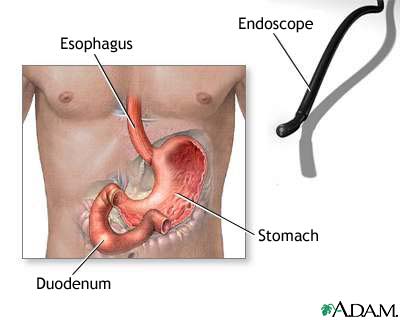Endoscopy procedure

Endoscopy - the collective term for minimally invasive procedures that allow the doctor to view internal organs and structures using a lighted, flexible scope inserted through a natural body opening or through a small incision. Endoscopy can be diagnostic or therapeutic. Most endoscopic procedures require preparation before the procedure, sedation during the procedure, and supervised recovery after the procedure.
The primary risks of endoscopic procedures are minimal, consisting of primarily INFECTION or bleeding that results from unintended ABRASIONS to the tissues. A very rare but serious complication of endoscopic procedures of the bowel is perforation, in which the endoscope goes through the wall of the bowel. This requires surgical repair and ANTIBIOTIC MEDICATIONS to prevent PERITONITIS. Most people return to full and regular activities the day after diagnostic endoscopy and within a few weeks after endoscopic operations.
| COMMON GASTROINTESTINAL ENDOSCOPY PROCEDURES | ||
|---|---|---|
| Procedure | Description and Purpose | Preparation |
| anoscopy | short, rigid scope for viewing the anal canal inserted through the ANUS diagnose HEMORRHOIDS, ANAL FISSURE, anal polyps, INFECTION |
bowel evacuation (LAXATIVES or ENEMA before the procedure) |
| colonoscopy | flexible scope with a camera for viewing the full length of the COLON inserted through the anus detect and remove INTESTINAL POLYP diagnose inflammatory or infectious conditions evaluate bleeding or possible ILEUS (intestinal obstruction) biopsy suspicious growths or tumors |
multiday bowel preparation, including dietary restrictions and a potent laxative to completely clear the colon intravenous sedation and pain medication during procedure |
| esophagoscopy | flexible scope with a camera for viewing the ESOPHAGUS inserted through the mouth diagnose esophagitis, BARRETT’S ESOPHAGUS, ESOPHAGEAL ATRESIA, HIATAL HERNIA, and ESOPHAGEAL CANCER evaluate SWALLOWING DISORDERS |
fasting for 6 to 12 hours before the procedure intravenous sedation and pain medication during the procedure |
| esophagogastroduodenoscopy (EGD) | flexible scope with a camera for viewing the esophagus, stomach, and DUODENUM inserted through the mouth diagnose esophageal conditions, PEPTIC ULCER DISEASE evaluate upper GASTROINTESTINAL BLEEDING or PAIN, swallowing difficulties, or INFLAMMATION |
fasting for 6 to 12 hours before the procedure intravenous sedation and pain medication during the procedure |
| gastroscopy | flexible scope with a camera for viewing the stomach inserted through the mouth take tissue samples to determine whether HELICOBACTER PYLORI is present cauterize bleeding ulcer |
fasting for 6 to 12 hours before the procedure intravenous sedation and pain medication during the procedure |
| laparoscopy | flexible scope with a camera for viewing the structures of the internal abdominal cavity inserted through a small incision in the abdominal wall diagnose and treat numerous conditions (PERITONITIS, HEPATIC ABSCESS, diverticular disease, CELIAC DISEASE, gallstones, GALLBLADDER DISEASE, APPENDICITIS, PELVIC INFLAMMATORY DISEASE [PID]) numerous surgical procedures (APPENDECTOMY, CHOLECYSTECTOMY, HERNIA repair) |
fasting for 6 to 12 hours before the procedure possible bowel cleansing (laxatives and enema) intravenous sedation and pain medication, epidural anesthetic, or general anesthetic |
| sigmoidoscopy | rigid scope or flexible scope with a camera for viewing the rectum and sigmoid colon inserted through the anus diagnose inflammation, infection, rectal polyps, rectal prolapse biopsy suspicious growths evaluate lower gastrointestinal tract bleeding |
bowel evacuation (laxative or enema before the procedure) |
See also ANTIBIOTIC PROPHYLAXIS; ARTHROSCOPY; BRONCHOSCOPY; CANCER PREVENTION; CYSTOSCOPY; MINIMALLY INVASIVE SURGERY; SURGERY BENEFIT AND RISK ASSESSMENT.
Open discussion on the topic Endoscopy procedure
Similar interests
- Nuovi Casino
- Casinos Not On Gamstop
- UK Casinos Not On Gamstop
- Casinos Not On Gamstop
- UK Casinos Not On Gamstop
- Casino Non Aams Italia
- Slot Sites Not On Gamstop
- Meilleur Casino En Ligne
- Non Gamstop Casino Sites UK
- Meilleur Casino En Ligne
- Casino En Ligne France
- Best Non Gamstop Casinos
- Casinos Not On Gamstop
- UK Casino Not On Gamstop
- Casinos Not Signed Up To Gamstop
- Best Slot Sites UK
- Non Gamstop Casino Sites UK
- Online Casinos Nederland
- Online Casinos Nederland
- Casinos Not On Gamstop
- Best New Uk Casinos Not On Gamstop
- Casino Non Aams
- Non Gamstop Casinos UK
- Migliori Siti Casino Non Aams
- Bitcoin Casinos
- Sites De Paris Sportifs Belgique
- Bookmaker Non Aams
- Casino En Ligne